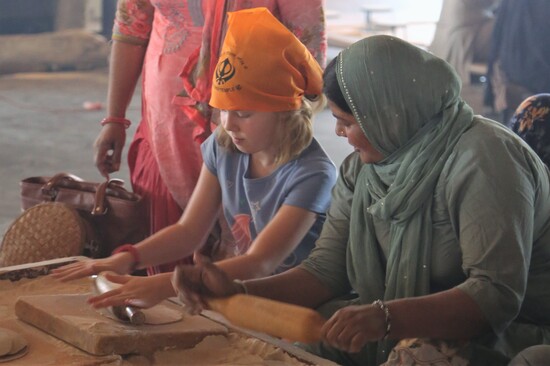Our time in India is winding down (less than 4 months to go, can you believe it??) and one of the few remaining places on our ‘must see’ bucket list for India was the city of Amritsar in the State of Punjab. You may be familiar with the state of Punjab for its food (Northern Indian cuisine is what’s predominantly served in America) or perhaps from the 1982 movie Annie and its culturally insensitive portrayal of Punjab, Daddy Warbuck’s Sikh bodyguard, who could hypnotize animals and make objects levitate. Alas, I digress…

Amritsar itself is famous for two specific things (at least on the tourist circuit), namely, the Wagah Border Ceremony (see my previous two posts) and the iconic Golden Temple, the holiest pilgrimage site for followers of the Sikh religion. It is estimated that roughly 100,000 visitors or devotees pass through its gates each day, making it one of the most visited sites in India.

The Golden Temple was begun in 1581 and took 8 years to complete. It has a 24-karat-gold foil covering that was added in 1830 during reconstruction after the temple was destroyed by Afghan raiders. The entire golden temple complex is a square, with entrances at the center of each side to represent that all are welcome. After entering, you come upon a sacred pond, at the center of which sits the Golden Temple, accessible via a walkway on one of the four sides. There are room inside to circumnavigate the pond and many devotees could be found either purifying themselves in the sacred waters or sitting alongside the pond in reflection or prayer.

Today, roughly 25-30 million people practice Sikhism, which makes it the 5th most practiced religion in the world. The religion originated in present-day Pakistan (what was then Indian Punjab) from the spiritual teachings of Guru Nanak. He became the faith’s first guru and was succeeded by nine others. The tenth guru declared the Sikh scripture as his successor, making the teachings the last eternal guru. This is unique in that Sikhs do not worship any idols.

Practicing Sikhs wear one or more of the articles of faith. These include: Having uncut hair that is protected by a turban, a small comb meant to keep one’s appearance tidy, an iron bangle, a specific undergarment, and a small knife or dagger (as a symbol of their duty to stand up to injustice). One of the core tenets of Sikhism is the belief that all people are equal, regardless of caste, race or gender. Sikhism also stresses the importance of doing good actions rather than merely carrying out rituals, which is why you’ll often hear of Sikhs providing humanitarian aid during world crisis, like the one happening in Ukraine.

One of the oldest and most beloved traditions in Sikhism is the practice of langar, meaning preparing and serving free meals to the public. In India, most Sikh temples are open 24 hours a day and have non-stop vegetarian meal service. All food is prepared by volunteers and, in accordance with the Sikh value of equality, all are welcome — and seated together on the floor to erase any class distinctions. We had the good fortune of visiting the temple’s community kitchen while on our tour and I couldn’t help but be awed by the magnitude of their operation, which feeds 50,000 people a day using only volunteer labor. Can you imagine coordinating that???

We started in the entry area where metal plates were being handed out to diners, while over to the side a circle of volunteers was cutting onions and potatoes. Next we ventured into the kitchen to see giant vats of food cooking, and the chapati production lines (both machine-made and by hand). Our guide asked Nia if she’d like to help roll out some chapati dough and she jumped at the chance, plopping herself down in the middle of a group of Punjabi women and getting straight to work. She amazes me sometimes!

We didn’t make it inside the actual golden temple itself because it was a two to three hour wait and we were already feeling quite drained from the heat. However, there were plenty of other people who had come from near and far to join that line, as this picture can attest to.

Despite not entering the actual golden temple, I still felt like our experience gave us a great overview of Sikhism. Amritsar definitely lived up to the hype and quite honestly, was right up there for me with the Taj Mahal, from a magnificence standpoint, that is. Don’t miss this place if you’re planning a trip to India—it is a great example of what makes India unique from a religious, historical and cultural standpoint.



